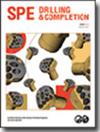Single Trip Deployment of Multistage Completion Liners Through the Use of Interventionless Flotation Collars
IF 1.2
4区 工程技术
Q3 ENGINEERING, PETROLEUM
引用次数: 0
Abstract
In difficult wellbores, the traditional method for deploying liners was to run drillpipe. The case studies discussed in this paper detail an alternative method to deploy liners in a single trip on the tieback string so the operator can reduce the overall costs of deployment. Previously, this was not often practical because the tieback string weight could not overcome the wellbore friction in horizontal applications. In each case, a flotation collar is required to ensure there is enough hookload for the deployment of the liner system. The flotation collars used are an interventionless design using a tempered glass barrier that shatters at a predetermined applied pressure. The glass debris is between 5 and 10 mm in diameter and can be easily circulated through the well without damaging downhole components. This is done commonly on a cemented liner and cemented monobore installations, but more rarely with openhole multistage completions. The authors of this paper have overseen thousands of cemented applications of this technology in Western Canada, the US onshore, Latin America, and the Middle East. For openhole multistage completions, the initial installation typically requires a ball drop activation tool at the bottom of the well to set the hydraulically activated equipment above. The effects of circulating the glass debris through one specific style of activation tool were investigated. Activation tools typically have a limited flow area and could prematurely close if the glass debris accumulates. Premature closing of the tool would leave drilling fluids in contact with the reservoir, potentially harming production. The testing was successfully completed, and the activation tool showed no signs of loading. This resulted in a full-scale trial in the field, where a 52-stage, openhole multistage fracturing liner was deployed using this technology. Through close collaboration with the operator, an acceptable procedure was established to safely circulate the glass debris and further limit the risk of prematurely closing the activation tool. This paper discusses the openhole and cemented multistage fracturing completion deployment challenges, laboratory testing, and field qualification trials for the single trip deployed system. It also highlights operational procedures and best practices when deploying the system in this fashion.通过使用无干预浮选套环一次性部署多级完井衬管
在困难的井筒中,部署衬管的传统方法是下钻杆。本文中讨论的案例研究详细介绍了一种在回接管柱上一次性部署衬管的替代方法,以便操作员可以降低部署的总体成本。以前,这通常并不实用,因为在水平应用中,回接管柱的重量无法克服井筒摩擦。在每种情况下,都需要一个浮动轴环,以确保有足够的钩载物用于部署衬管系统。所使用的浮选套环是一种无干预设计,使用在预定施加压力下破碎的钢化玻璃屏障。玻璃碎片的直径在5到10mm之间,并且可以容易地循环通过井而不损坏井下部件。这通常在胶结衬管和胶结单体装置上进行,但很少在裸眼多级完井中进行。这篇论文的作者已经监督了这项技术在加拿大西部、美国陆上、拉丁美洲和中东的数千次胶结应用。对于裸眼多级完井,初始安装通常需要在井底安装一个落球激活工具,以设置上面的液压激活设备。研究了玻璃碎片通过一种特定类型的活化工具循环的影响。激活工具通常具有有限的流动区域,如果玻璃碎片积聚,可能会过早关闭。过早关闭工具会使钻井液与储层接触,可能会损害生产。测试已成功完成,激活工具未显示加载迹象。这导致了现场的全面试验,使用该技术部署了52级裸眼多级压裂衬管。通过与操作员的密切合作,制定了一个可接受的程序,以安全地循环玻璃碎片,并进一步限制过早关闭激活工具的风险。本文讨论了裸眼和胶结多级压裂完井部署的挑战、实验室测试和单起下钻部署系统的现场鉴定试验。它还强调了以这种方式部署系统时的操作程序和最佳实践。
本文章由计算机程序翻译,如有差异,请以英文原文为准。
求助全文
约1分钟内获得全文
求助全文
来源期刊

SPE Drilling & Completion
工程技术-工程:石油
CiteScore
4.20
自引率
7.10%
发文量
29
审稿时长
6-12 weeks
期刊介绍:
Covers horizontal and directional drilling, drilling fluids, bit technology, sand control, perforating, cementing, well control, completions and drilling operations.
 求助内容:
求助内容: 应助结果提醒方式:
应助结果提醒方式:


